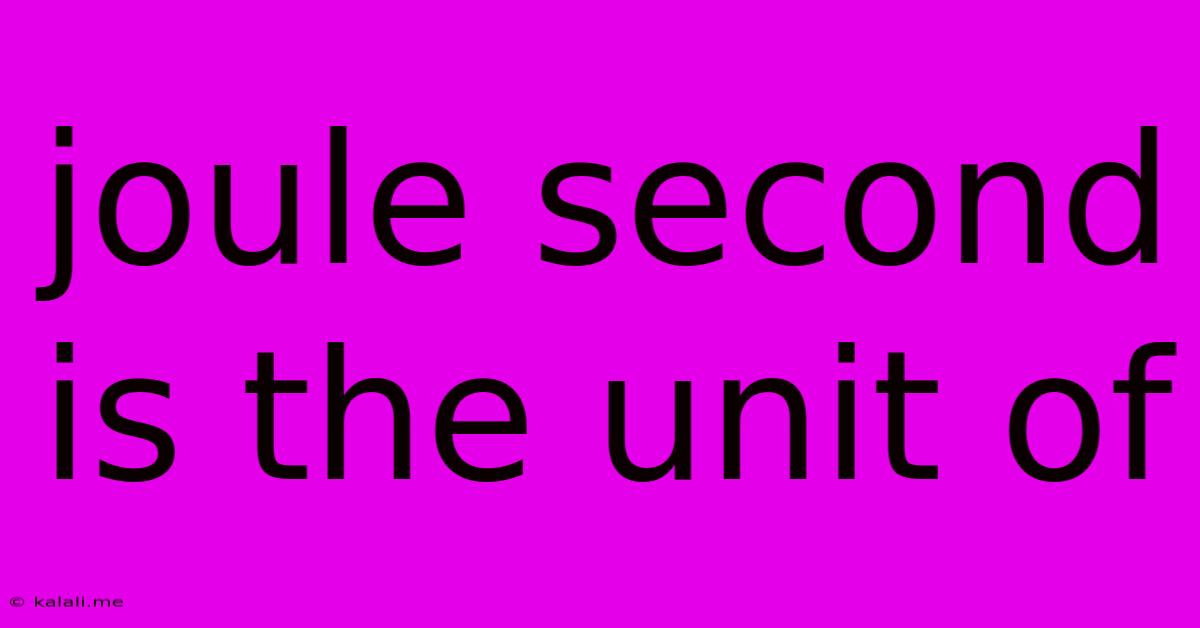Joule Second Is The Unit Of
Kalali
Jun 14, 2025 · 3 min read

Table of Contents
Joule-Second: The Unit of Action
The joule-second (J·s) might not be a household name like the meter or the kilogram, but it represents a fundamental concept in physics: action. This article will delve into what action is, why the joule-second is its unit, and explore its applications in various scientific fields. Understanding the joule-second provides insight into the deeper workings of the universe, from quantum mechanics to classical mechanics.
The joule-second is a unit derived from two fundamental SI units: the joule (J), the unit of energy, and the second (s), the unit of time. This seemingly simple combination holds significant meaning within the context of physics.
What is Action?
In physics, action (often denoted by the letter S) is a quantity that describes the evolution of a system over time. It's a scalar quantity, meaning it has magnitude but no direction. Action is calculated by integrating the Lagrangian (L) of a system over time:
S = ∫ L dt
where:
- S is the action
- L is the Lagrangian (kinetic energy minus potential energy)
- dt represents an infinitesimal increment of time
The Lagrangian itself is a function of a system's generalized coordinates and their time derivatives. Don't worry if this sounds complex; the crucial point is that action quantifies the history of a system's movement.
The Significance of the Joule-Second
The integral of the Lagrangian, with units of energy multiplied by time, results in the joule-second (J·s). The importance of action lies in its role in several key principles:
-
Hamilton's Principle of Least Action: This fundamental principle in classical mechanics states that a system evolves in such a way that the action is minimized. This principle elegantly explains the trajectory of particles and the motion of objects.
-
Quantum Mechanics: In quantum mechanics, action plays a critical role in determining the probability amplitudes of different physical processes. The action is related to the phase of a quantum mechanical wave function. This is evident in Feynman's path integral formulation of quantum mechanics.
-
Noether's Theorem: This theorem connects symmetries in a physical system to conserved quantities. For instance, if a system's action is invariant under time translation (meaning its behavior doesn't change over time), then energy is conserved. Similarly, invariance under spatial translations leads to the conservation of momentum.
Applications of the Joule-Second
While not as prominently featured as other units, the joule-second finds its application in various specialized areas:
-
Advanced Physics Research: Action is crucial in theoretical physics, especially in areas like quantum field theory and string theory. Researchers utilize it to describe the dynamics of particles and fields.
-
Computational Physics: Numerical methods often rely on calculations involving action to simulate physical systems, particularly those governed by classical or quantum mechanics.
-
Optics and Photonics: While less direct, the underlying principles related to action and its implications are pertinent in the study of light and its interactions.
Conclusion
The joule-second, as the unit of action, might not be immediately familiar, but its significance in the theoretical foundations of physics cannot be overstated. Understanding action provides crucial insights into the fundamental laws governing the universe, from the smallest quantum particles to the largest celestial bodies. It serves as a reminder that even seemingly obscure units play vital roles in our comprehension of the physical world. The applications and implications of the joule-second continue to expand as our understanding of physics deepens.
Latest Posts
Latest Posts
-
T20 World Cup 2030 Host Country
Jun 15, 2025
-
Copper And Zinc Alloy Is Known As
Jun 15, 2025
-
Sample Of Letter To Close Bank Account
Jun 15, 2025
-
What Is A Psychrometer Used For
Jun 15, 2025
-
Select All The Correct Statements About Limestone And Marble
Jun 15, 2025
Related Post
Thank you for visiting our website which covers about Joule Second Is The Unit Of . We hope the information provided has been useful to you. Feel free to contact us if you have any questions or need further assistance. See you next time and don't miss to bookmark.